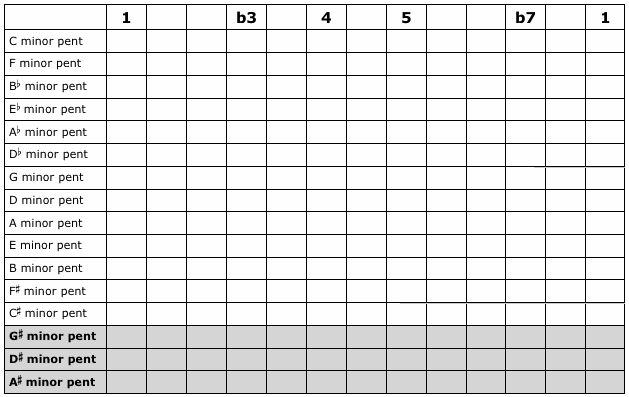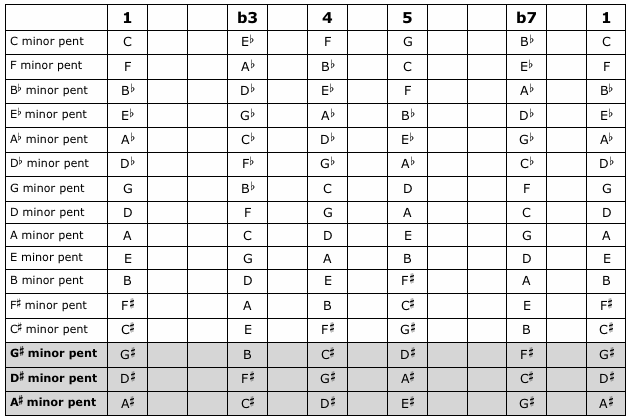In this lesson we’ll explore how the minor pentatonic scale can easily be created from the major scale. If you’ve forgotten how the major scale is constructed, then you’ll need to quickly review that before starting with this lesson.
So how do we build a minor pentatonic scale from the major scale? In order to answer that, there’s a few bits of information we need…
Scale Degrees Of The Major Scale
Go back and have a look at the table that you filled in for the major scale. Notice how at the top there are some numbers. Have a look below to see what I mean…
![]()
These numbers are called scale degrees. Some people call this the musical spelling of the major scale.
Musical Spelling Of The Minor Pentatonic Scale
The next bit of information we need is the musical spelling of the minor pentatonic scale. Luckily, I can give you it! The minor pentatonic has the following musical spelling…
![]()
One of the first questions some students of mine ask about this is “How do you pronounce it?”. The musical spelling is pronounced: “One, Flat Three, Four, Five, Flat Seven”.
All clear so far? Awesome!
How To Use The Musical Spelling Of The Minor Pentatonic Scale
The last thing we need to know is how to use the musical spelling of the minor pentatonic scale. At this stage it’s really important to note the following…
The musical spelling tells us what we have to do to the major scale in order to create a minor pentatonic scale.
It’s probably a really good idea to go through an example to make it really clear for you…
Example: A Minor Pentatonic Scale
Let’s work out the notes of the A minor pentatonic scale.
Step 1: Write out the notes of the A major scale. This gives us…

Step 2: Because the musical spelling of the minor pentatonic scale doesn’t include a 2 or 6, we need to remove these from the A major scale. So this would give us…

Step 3: Because the musical spelling of the minor pentatonic scale has a b3 and a b7, we need to flatten the 3 and 7 of the A major scale. Doing this would result in…

Now It’s Your Turn
Please work out the following minor pentatonic scales, print out this webpage, and then fill out the following table…

Have another quick look at this table. Why have I used a darker background for the G#, D# and A# minor pentatonics?
I’ve used a darker background because you can’t use the normal method to work these ones out. This is because there are no G#, D# or A# major scales. If you don’t believe me have a look at the major scale table you filled out in an earlier lesson. See, I told you! 🙂 So how do we work these out? Any ideas?
A Quick And Nasty Method
Probably the easiest way to work out these three weirdos is to take a normal one and sharpen all the notes. Have a look at the example below to see what I mean…
Example: G# Minor Pentatonic
Let’s work out the G# minor pentatonic scale.
Step 1: Write down the notes of the G minor pentatonic scale…
G Bb C D F G
Step 2: Sharpen all the notes. Keep in mind that when you sharpen Bb it would become B. This gives us…
G# B C# D# F# G#
Simple huh?
Let’s now look at the answers for the table you filled out earlier…

Some Recommended Things To Do
It’s very important to put this theory immediately to use. So here are a few things that I’d like for you to do…
Action Step 1:
Map the notes of the following minor pentatonic scales onto the blank fretboard diagrams I’ve put at the bottom half of this page…
- Dm Pentatonic
- Em Pentatonic
- Am Pentatonic
Action Step 2:
Make up and record a progression that uses at least two of the following chords…
- C major
- D minor
- E minor
- F major
- G major
- A minor
Action Step 3:
Improvise over the chord progression that you recorded for Action Step 2. Experiment with using the notes from the three minor pentatonic scales that you mapped out for Action Step 1.
Dm Pentatonic: D F G A C

Em Pentatonic: E G A B D

Am Pentatonic: A C D E G

